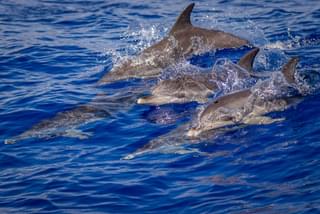Common bottlenose dolphin

Tursiops truncatus
1.8 - 3.9m
Grey
Teeth
Dorsal fin
The bottlenose dolphin is the most familiar dolphin, appearing in aquariums, the press, and commonly seen from coastlines around the globe. It is much larger than many dolphin species, reaching almost 4m in length. It has a grey colouration which fades to white on its belly. It has a curved head with a thick rounded melon overhanging a stubby beak and a stocky build.
Keay features:
- Crease between melon and thick beak
- Tall, curved, central dorsal fin
- Uniform grey colouration
- Active, often porpoising energetically
Behaviour
Bottlenose dolphins travel in groups of 1-25 individuals and aggregate to form larger groups. They are fast and acrobatic, often breaching, tail slapping, bow and wake riding and are capable of impressive acrobatics, leaping high out of the water and somersaulting. They can be aggressive towards their own species and other species. Bottlenose dolphins are very sociable animals and are often seen with other dolphin’s particularly white-beaked dolphins in the North Sea.
Threats
A major threat to bottlenose dolphins, as well as other dolphins is habitat degradation through increased pollution, rubbish, sewage outflow and sedimentation in marine waters. Coastal bottlenose dolphin populations are particularly vulnerable to this living in such close proximity to the shoreline. Bottlenose dolphins are the classic aquarium species creating a demand for them to be taken from the wild, this is particularly the case in Japan where bottlenose dolphins are also being hunted. For many of the coastal populations fisheries also pose a threat through entanglement.
Distribution
Bottlenose dolphins have a global distribution in temperate and tropical seas. They occur in distinct populations both coastal and offshore, with the offshore animals being slightly larger in size. Coastal populations can be spotted in all European waters.
The bottlenose dolphin is one of two cetacean species that are protected under the EU Habitats Directive. Around the UK and Ireland four Special Areas of Conservation (SAC’s) have already been designated to protect the bottlenose dolphin. All of these SACs are home to what are believed are semi-resident bottlenose dolphin populations.







Study whales and dolphins as an ORCA OceanWatcher
The ORCA OceanWatchers online training course, along with a bespoke app, will enable everyone to collect data about whales, dolphins and porpoises. And it can be collected from anywhere that you can see the sea - whether that’s from your local beach, on holiday at the coast, scanning the seas from a cruise ship, travelling via ferry, or from your own boat.
You may also be interested in



